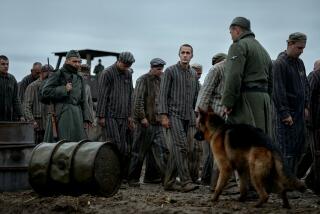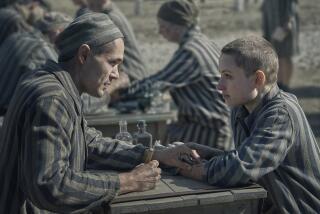Book Review : Holocaust Comic Book Not Quite Up to the Task
- Share via
Maus: A Survivor’s Tale by Art Speigelman (Pantheon: $8.95)
Before mass literacy, satirical drawings were a common vehicle for social and political commentary: During the Reformation, the Pope was caricatured as the Antichrist and Martin Luther as Satan in disguise. As comic books have largely been restricted to mindless diversions in America, Art Speigelman’s effort to infuse serious content into his drawings seems more daring than it really is.
In this first collection of his work from Raw comics, Speigelman attempts to depict his troubled relationship with his father, a concentration camp survivor, and show how the older man survived in Poland from the beginning of the Nazi persecution to his arrival at Auschwitz in 1944. (A second volume, devoted to his later experiences, has already been announced.)
Fractured Grammar
Speigelman has accurately reproduced his father’s narrative, down to the fractured grammar. (“It would take many books, my life, and no one wants anyway to hear such stories.”) But he merely records the man’s behavior, without explaining why he acts as he does. Speigelman illustrates his father’s extreme parsimony--a common trait among Holocaust survivors--but fails to explore its origins in the utter deprivation of the ghetto.
An exceptional graphic artist--George Grosz, Ralph Steadman or Winsor McCay--might have captured some of the hatred, anger and fear that the Holocaust engendered. Speigelman’s draftsmanship is inadequate for the task. He draws the Polish Jews as mice, but fails to establish them as characters: The mouse that represents his father is indistinguishable from the others. The reader can’t tell one mouse from another, let alone feel any sympathy for them.
Clumsy Drawings
Comic-book characters and actions are caricatures based on exaggeration, but the crimes the Nazis perpetrated against their victims are too terrible to exaggerate. A clumsy drawing of mice being hanged or tortured simply does not command the visual power of the photographs of human victims. Making the Jews mice, the Nazis cats and the Christian Poles pigs undermines the central horror of the Holocaust. Its cruelties were not the product of a conflict between two species with an inborn adversarial relationship, but by members of the same race, divided only by a specious ideology.
Speigelman’s work has attracted favorable critical comment, probably because of its highly emotional subject. The story of how the victims of a society’s irrational hatred were physically isolated as a prelude to their extermination has a chilling currency in California today, when Proposition 64, the LaRouche initiative, proposes the quarantining of AIDS sufferers. But this terrible and heroic narrative deserves a more eloquent vehicle than a badly drawn comic book.
More to Read
The biggest entertainment stories
Get our big stories about Hollywood, film, television, music, arts, culture and more right in your inbox as soon as they publish.
You may occasionally receive promotional content from the Los Angeles Times.










